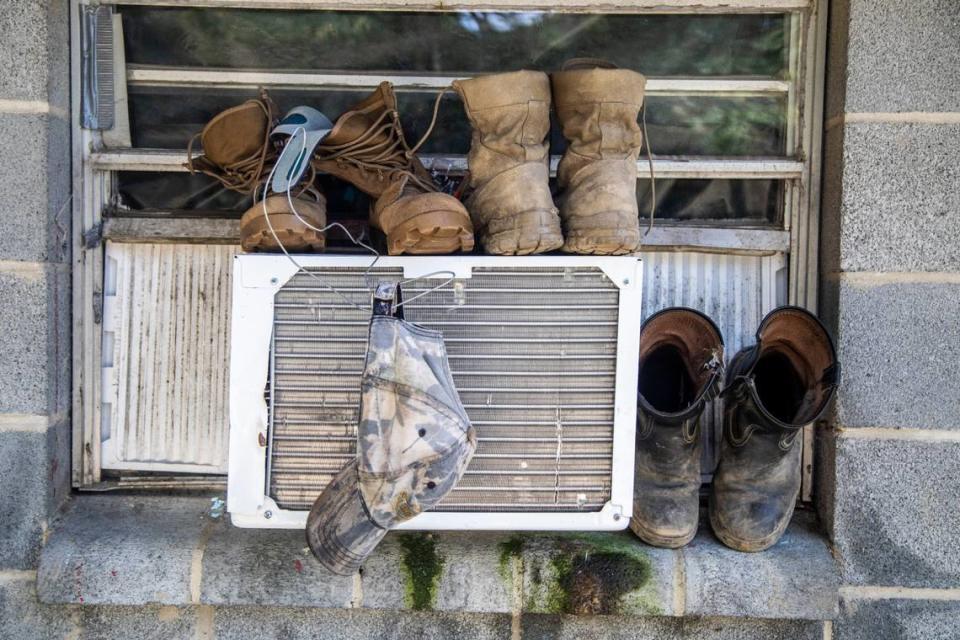A federal heat proposal could be ‘a good step’ for NC workers, advocate says
A proposed federal rule would provide North Carolina workers with specific protections from high temperatures, if it goes into effect.
The U.S. Occupational Health and Safety Administration has proposed a heat injury prevention plan that requires employers to take steps to protect their workers, like providing shade when certain temperature thresholds are met or drafting a heat injury prevention plan that gives specific directions to where work is happening.
The plan is the first ever federal heat standard. If implemented, it would also be the first explicit heat health protection for North Carolina’s workers, including in the state’s agriculture and construction fields.
Right now, workers are covered by the state’s General Duty clause, which allows the N.C. Department of Labor to cite an employer if it fails to provide a workplace that is safe from a threat that could cause injury or death. Critics have long argued that the state fails to outline exactly how employers should protect their workers from heat.
MaryBe McMillan, the president of the N.C. State AFL-CIO, said a farmworker’s death last year and other recent events make it clear that workers aren’t being adequately protected from extreme heat under North Carolina’s existing regulations. McMillan also pointed to warehouse workers in facilities that don’t have air conditioning and workers on the Tarmac at airports as other examples of workers who are exposed to potentially dangerous levels of heat.
“There’s all kinds of workers in various industry sectors who every day are experiencing high degrees of heat and don’t have any opportunity to get relief, and that’s a real problem,” McMillan said.
What’s in OSHA’s proposed rule?
The proposed OSHA rule has two different triggers that require employers to provide protections, with a higher heat index requiring more precaution. Heat index is a measurement that uses air temperature and humidity to capture what conditions feel like for the human body.
Under the rule, every employer would need a written heat illness prevention plan, readily available at the work site in the language spoken by employees. That plan would include a list of emergency phone numbers, as well as clear directions to a work site that could be provided to emergency dispatchers or directions for how someone suffering from heat illness could be transported to a place where emergency services could reach them.
When the heat index is 80 degrees Fahrenheit, the federal government proposes, an employer must:
Provide enough cool drinking water that each employee can drink a quart of water per hour.
Provide areas for employees to take breaks in shade or air conditioning. The employer must also allow and encourage paid breaks.
Provide cool break areas at indoor work sites, using fans, air conditioning or dehumidifiers.
Maintain effective two-way communication with employees.
Restrict work when an employee is new or returning from a break to allow them to acclimatize to the temperatures.
When the heat index reaches 90 degrees Fahrenheit, the government proposes additional safety measures. Those include:
Giving employees a paid 15-minute break in a shady or cool area every two hours.
Implementing an observation system for signs of heat illness, like a buddy system where employees keep an eye on each other or a system where a supervisor observes up to 20 employees.
Giving employees a hazard alert before their shift begins, including telling them they have a right to take a break, stressing the importance of drinking water and letting them know how to seek help in the case of heat illness.
Impact on NC workers, businesses
Last year, José Alberto Gonzalez Mendoza, a 30-year-old farmworker, died in Nash County while picking sweet potatoes. The N.C. Department of Labor fined Barnes Farming Corp. $187,509 in connection with Mendoza’s death, finding that the farm had workers in the fields on a 91-degree day without a regular rest schedule, provided a five-minute break in a six-hour period and did not provide enough drinking water for workers, among other violations.
The proposed OSHA rule would help farmworkers in North Carolina, as long as it can be enforced, said Yesenia Cuello, the executive director of NC FIELD, a Kinston-based farmworker advocacy organization.
“It’s a good step to mandate employers to create comprehensive heat illness prevention plans and things like that. We know that this would ultimately reduce the risk of heat-related illnesses — and honestly, fatalities — because the reality is that heat can kill,” Cuello said.
Still, Cuello sees gaps in the proposed rule, especially as it pertains to farmworkers.

NC FIELD’s outreach workers have seen heat illness among employees when they return to farmworker housing that has little or no cooling, she said. In some instances, Cuello said, NC FIELD staff have seen farmworkers sleeping under mobile homes provided by employers instead of inside of them because it is so much cooler there.
There is no state or federal rule requiring farmworker housing to have cooling.
“A lot of what we’re seeing — heat-related illnesses and heat stress — doesn’t happen in the fields but once they’ve gotten home and they’ve had time to settle,” Cuello said.
Additionally, Cuello added, it is important that emergency dispatchers have distinct addresses or GIS markers for farmworker housing because heat emergencies frequently happen there.
The NC Farm Bureau did not have anyone available to comment for this story.
Construction companies are already practicing heat safety in ways that would be codified by the proposed rule, Jeffrey Shoaf, the safety director for the Associated General Contractors of America, wrote in an emailed statement.
Shoaf also critiqued the proposal, writing that it fails to consider how regional weather patterns could impact workers’ ability to handle heat and that workers should play a role in protecting themselves. During periods of high heat, Shoaf wrote, workers should be drinking plenty of water; avoiding drinks that contain alcohol or caffeine; and understanding how certain medical conditions or medications can bring added risk.
“Overall, this proposed new rule provides a starting point for creating measures to protect workers that are based on what the industry is already doing. We look forward to working with federal officials to craft a final rule that includes effective measures for firms and workers to follow,” Shoaf wrote.
In North Carolina, the Carolinas Associated General Contractors chapter recommends construction companies develop a plan to address heat illnesses in the workplace, Jacob Garmon, the organization’s director of safety, suppliers and sponsorships, wrote in an email.
“Due to North Carolina’s climate being above the initial 80 degree threshold a majority of the year this would be of concern to our industry. However, our members are already providing a lot of the required protections (water, breaks, acclimatization etc.) to meet this standard to the best of their ability,” Garmon wrote.

Where do NC’s labor commissioner candidates stand?
If the federal rule becomes effective, North Carolina’s labor commissioner would be the person tasked with either pushing for it to become the state’s heat rule or crafting a North Carolina alternative.
This fall, North Carolina voters will elect a new person to the office, either Democrat Braxton Winston or Republican Luke Farley. Josh Dobson, the sitting labor commissioner, did not seek reelection.
Farley has been an outspoken critic of OSHA’s effort to regulate heat, arguing the different climatic conditions across the country make a federal regulation unworkable.
“There’s no question that we need to protect North Carolina’s workers from heat,” Farley said in an interview. “The question is, what’s the best way to do it? We don’t need a one-size-fits-all federal mandate from the Biden administration, we need a North Carolina solution to protect North Carolina workers.”
If elected, Farley said, he would not seek to adopt the federal rule as written. Instead, Farley said he would work to craft a similar proposal that would seek to provide the same amount of protection while being less burdensome for businesses.
Braxton Winston, the Democratic candidate for Labor commissioner, has made heat a central issue in his campaign. On his website, Winston calls for explicit protections from heat for workers, including a heat sickness prevention plan; training to help employees and supervisors respond to heat illness; clean drinking water; and shade.
OSHA’s proposal is a positive for North Carolina’s workers, Winston said in an interview, adding that he looks forward to participating in the rulemaking process.
“High temperatures are getting hotter and are sticking around longer, and while work can be tough, work should never be deadly. And the the truth is, hotter temperatures for longer periods of time is making work more dangerous in North Carolina and we need more protections for workers and businesses from the impact of high heat where work gets done,” Winston said.
This story was produced with financial support from the Hartfield Foundation and Green South Foundation, in partnership with Journalism Funding Partners, as part of an independent journalism fellowship program. The N&O maintains full editorial control of the work. If you would like to help support local journalism, please consider signing up for a digital subscription, which you can do here.


